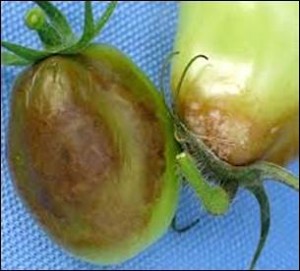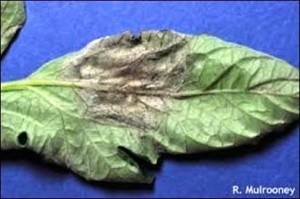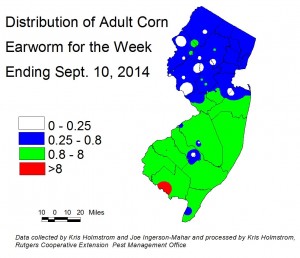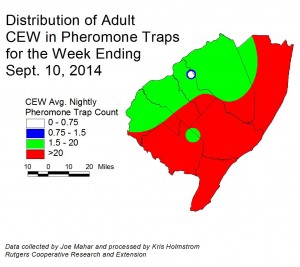Topics for the Week
- Sweet Corn
- Peppers
- Tomatoes
- BMSB
- Pumpkins and Winter Squash
- Cole Crops
Maps for the Week
–European Corn Borer Map
–Corn Earworm Moth Blacklight Trap Map
–Corn Earworm Moth Pheromone Trap Map
–Pepper Weevil Trap MapVegetable IPM Report 9-10-14 – Click to View | Download | Print
Sweet Corn
European Corn Borer (ECB) adult activity has declined further, with only scattered individuals being captured throughout New Jersey (see ECB map). Egg laying is largely over, but larvae are active in plants. Whorl and pre-tassel stage feeding is interspersed with more dominant fall armyworm (FAW) feeding. As always, consider treating if 12% or more plants exhibit ECB feeding alone, or in combination with FAW (see below) injury. Remember to make a full-tassel application to control ECB larvae as they leave the tassel and travel down the stalk to re-enter the plant near the ear shank. This last application is often critical to controlling ear infestations from ECB.
| The highest nightly ECB catches for the previous week are as follows: | |||||
| Allentown | 1 | Jones Island | 1 | Milltown | 1 |
| Califon | 1 | Lawrenceville | 1 | New Egypt | 1 |
| Eldora | 1 | Long Valley | 1 | Pennington | 1 |
| Folsom | 1 | Medford | 1 | Phillipsburg | 1 |
Blacklight Trap: Corn earworm moths (CEW) are on the increase in New Jersey. CEW moth numbers, particularly south of Trenton, have gone up significantly (see CEW blacklight map). North of Trenton, captures have risen as well, but not to the same degree. This level of activity is more typical of what CEW is capable of in September, although it is still lower than most years, and quite late. At these levels, CEW will damage most sweet corn ears if not controlled.
| The highest nightly CEW trap catches are as follows: | |||||
| Jones Island | 17 | Crosswicks | 4 | Eldora | 3 |
| Georgetown | 7 | Medford | 4 | Hackettstown | 2 |
| New Egypt | 6 | Woodstown | 4 | Newton | 2 |
| Springdale | 5 | Centerton | 3 | Tabernacle | 2 |
Pheromone Trap: CEW pheromone trap catches have increased over the past week, along with blacklight catch numbers. Greatest activity is still from the Atlantic – Camden County border south through Cape May (see CEW pheromone trap map), with some Cape May pheromone traps registering high catches. The red area on the map roughly corresponds to a 3-day silk spray schedule. Low spots within the broader colored areas should be considered outliers, and grower near those areas should defer to the more conservative schedule. Sweet corn plantings now in silk in southern NJ are at risk for ear infestation if CEW is not properly controlled.
| The highest nightly CEW pheromone trap catches are as follows: | |||||
| Green Creek | 94 | Elm | 32 | Beckett | 16 |
| Eldora | 65 | East Vineland | 18 | Pedricktown | 13 |
Silking Spray Schedules*
South: 3 days
Central: 3 days
North: 3-4 days
*Note: These are general recommendations. Local trap catches may indicate some variation in the frequency of insecticide applications to silking corn.
Fall armyworm (FAW) infestations are occurring throughout the state. Re-infestation within 1 week of treatment is common. It is important that all plantings be scouted regularly for this pest. FAW caterpillars consume corn foliage, and produce large quantities of feces that pile up within the whorl. FAW larvae typically have light and dark brown bands, and the head capsule has a distinctive upside-down “Y” pattern on it. Unlike ECB, FAW will feed on corn plantings in the seedling stage, although whorl stage is usually the first to be affected. Consider treating if the number of plants infested with FAW either alone, or in combination with ECB exceeds 12%. FAW may be difficult to control with pyrethroid insecticides. Newer materials, including spinosad-based insecticides, as well as those including active ingredients chlorantraniliprole and flubendiamide are effective against BAW.
Foliar Diseases of Sweet Corn are common now, and will remain with us for the duration of this season. These include corn leaf rust (CR) and northern corn leaf blight (NCLB). Both CR and NCLB can negatively impact ear development if they become heavy on foliage. CR causes ruptures in the leaf surface, resulting in moisture loss that stresses the plant. NCLB reduces the amount of photosynthetic surface available to the plant. Both are more serious the earlier they develop on corn plants. Generally, if the first signs of disease occur after the pre-tassel stage, damage will likely be confined to cosmetic blemishes on the husk. If infections first appear in the whorl stage, the possibility exists for ear size to be reduced as the plants struggle to compensate for water loss and reduced leaf surface. Consult the 2014 Commercial Vegetable Production Recommendations for specific fungicide recommendations, but be aware that the strobilurin class (FRAC Grp. 11) has provided poor results on NCLB in the northern parts of the state.
Peppers
Beet armyworm (BAW) have been captured in southern counties. Most traps are catching just a few moths, and even traps in the Folsom and Woodstown areas have declined to below 15/night for the past week. BAW larvae will feed on leaves near the growing terminals of the plants, resulting in shredded foliage at the top. As the larvae molt and grow larger, they will begin feeding on fruit. BAW, like FAW is difficult to manage with pyrethroid insecticides. Materials that are recommended for FAW control (see the FAW paragraph above), will also be effective against BAW.
Pepper Weevil Report: Trap counts increased to 29 for the trap outside of Swedesboro, the highest counts since May 13 when 83 weevils were caught at the same location. Another infested field of peppers was found in Salem County and single weevils were trapped in two other fields (See attached map).
Weevil infestations are unlikely to cause significant yield loss at this time of year, especially when growers are going for their last picks of the season. Cool night-time temperatures will slow the weevil life cycle so that it will take longer for the growth and development of the weevil grubs.
Those growers who will still have peppers in high tunnels and greenhouses will still be at risk of PW infestations. In December, 2012, a local greenhouse with peppers was infested.
Tomatoes
Two-spotted spider mite (TSSM) infestations are occurring in most tomato plantings in north and central NJ, as drier weather dominated in these areas. Initially, this pest may go unnoticed. As numbers increase, foliage will become yellow, and ultimately turn brown and dry. At this point, TSSM webbing will be obvious, connecting leaves so that mites can move about the plant to less populated areas. TSSM is best managed while still at low levels. Look for the mite “stipple” (whitish pin-spots), indicating a low level population under the affected leaf. If this sign of infestation is present in multiple sites within the field, consider applying one of the newer miticides. There are a number of effective materials that have very short pre-harvest intervals. Consult the 2014 Commercial Vegetable Production Recommendations for specific insecticide recommendations.
Foliar Diseases of Tomato: Longer dew periods and older plants result in higher incidence of foliar disease in tomatoes. Early blight, and septoria are familiar occurrences in tomato plantings now. Some heirloom varieties (green striped varieties in particular) express early blight symptoms that are more extreme than those found on more typical commercial varieties. In some cases, these early blight lesions are reminiscent of late blight, in that they can appear on younger foliage, and infected tissue may be dry and gray rather than tan with concentric rings. Early blight lesions will not develop whitish sporulation that is characteristic of late blight lesions. It is critical that thorough coverage be achieved when applying fungicides. Consult the 2014 Commercial Vegetable Production Recommendations for specific fungicide rotations.
Be aware that late blight has been confirmed in Mercer County as of this week. Please refer to Dr. Andy Wyenandt’s Vegetable Disease Briefs of 9/8/14 for further details. All growers in surrounding areas should be applying fungicides that specifically target late blight in addition to their normal protectant fungicide program. For organic growers, fixed copper formulations should be applied preventively and at frequent, regular intervals to provide coverage to new growth. Individual plants showing late blight symptoms (see photos) should be rogued.

Late blight infection on plum tomatoes. Note that infected fruit remain solid. Photo: Cornell University

Late blight foliar lesion. Note presence of whitish sporulation at lesion margin.
Photo: Bob Mulrooney, UDelaware.
Brown Marmorated Stinkbug (BMSB)
BMSB activity remains very low, with no trap in the state capturing more than 3/night. Adult activity continues to be well behind previous years. If adult captures increase to 5/night for a full week, maps will be produced to show where activity is highest. Information on scouting, crop injury and control will also be included.
Pumpkins and Winter Squash
Cucurbit downy mildew (CDM) is active on cucumbers in New Jersey. Reports from PA and NY indicate that DM is impacting cucumbers there as well. As of Tuesday, IPM personnel have detected no other cucurbit crops with DM infections. However, given the virulence of CDM, it is advisable that pumpkin growers begin to add fungicides that specifically target CDM to their regular protectant program for powdery mildew (PM).
The CDM website http://cdm.ipmpipe.org/ indicates high risk of spread into southern New Jersey from infection sites to our south for the first part of this week. It is important to note that to date; only cucumbers have been affected. Heavy dew periods will cause existing field infections to worsen unless excellent coverage with proper fungicides is achieved. This website should be a “favorite” on every grower’s web browser. It is advisable that all growers scout crops at least twice a week. Any further occurrence will be reported in this newsletter and will also generate an alert to all subscribers.
Powdery mildew (PM) is active on vine crops in all areas. Check upper and lower surfaces of 2 mature leaves per plant on 5 consecutive plants each, in 10 locations throughout the field. When PM lesions are found on 2 or more leaves, begin a weekly protectant fungicide program. See the 2014 Commercial Vegetable Production Recommendations for materials useful in managing CDM and PM. It is critical that recommended fungicides be rotated to reduce the possibility of the organism developing resistance to effective materials.
Cole Crops
The pest situation for cole crops remains unchanged. Cabbage looper (CL) infestations are fairly common, as well as diamondback moth (DBM), imported cabbage worm (ICW). In central NJ, a few beet armyworm (BAW) larvae have begun to turn up in samples. Scout plantings weekly. Check 5 consecutive plants each in 10 random locations throughout the planting, paying particular attention to the innermost leaves where ICW often feed. Consider treating if caterpillars are found on 10% or more plants that are in the 0-9 true leaf stage. From 9-leaf to the early head stage (in broccoli, cauliflower and cabbage) infestations up to 20% may be tolerated. Once heads begin to form, a 5% threshold should be observed to protect the marketable portion of the plant. For leafy greens such as collards and kale, 10% plants infested is the threshold throughout. It is important to identify DBM and BAW correctly, because if it present, synthetic pyrethroid insecticides may not provide acceptable control. DBM larvae are small, and taper toward both ends. They thrash vigorously when disturbed. BAW are green with a pale stripe down each side and a prominent dark spot on each side of the second segment behind the head.
In parts of central NJ, new broccoli and collard plantings are developing crucifer downy mildew (CrDM) infections. CrDM caused necrotic spots to develop on the upper surface of older leaves. Inspection of the lower leaf surfaces will show pale purple sporulation (see photo at right) erupting from the infected tissue. This disease can be especially hard on broccoli and collard greens, so growers should actively scout plantings at least weekly. Cole crops should be treated with appropriate fungicides at the first occurrence of this disease. Consult the 2014 Commercial Vegetable Production Recommendations for specific fungicide recommendations.
All current and archived Vegetable IPM Maps including European corn borer, corn earworm and brown marmorated stink bug population maps are available for viewing @ http://tinyurl.com/njaes-ipm-maps





